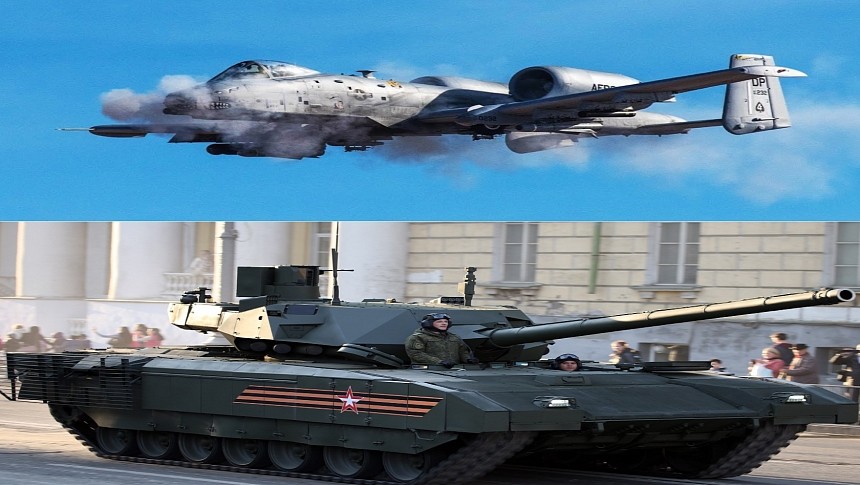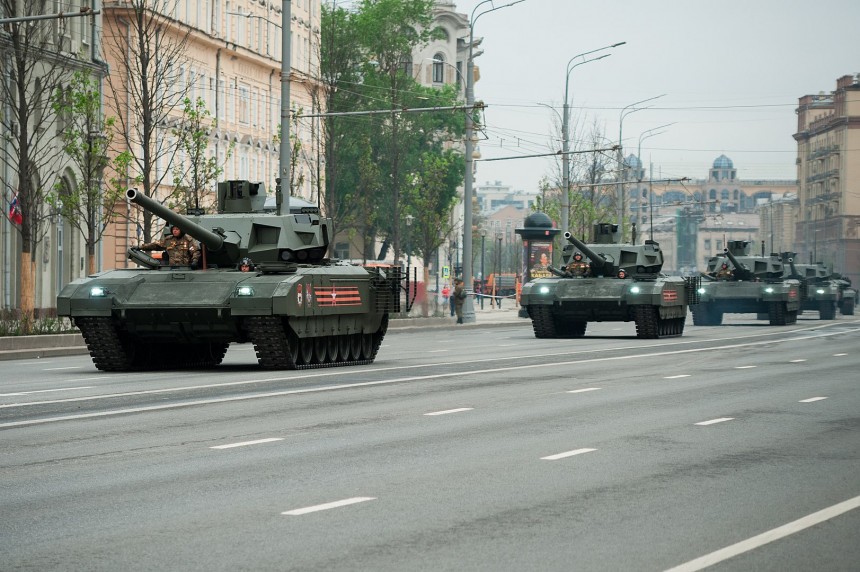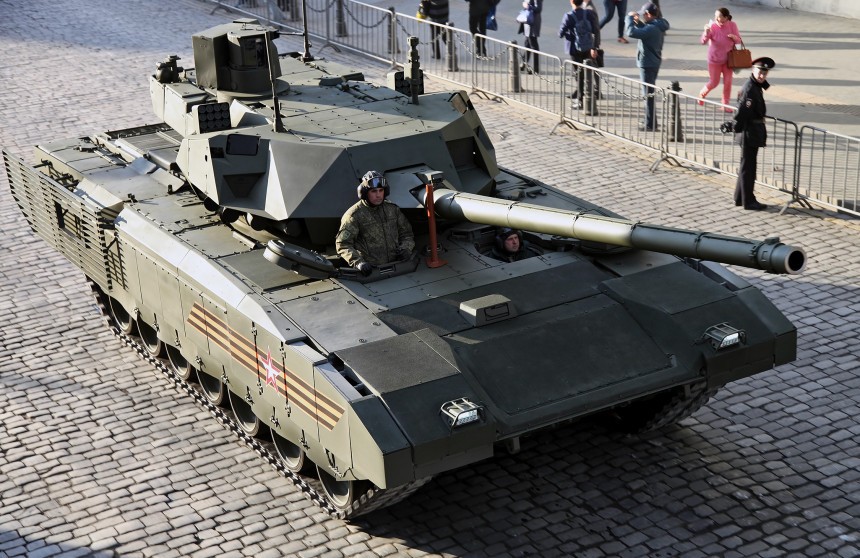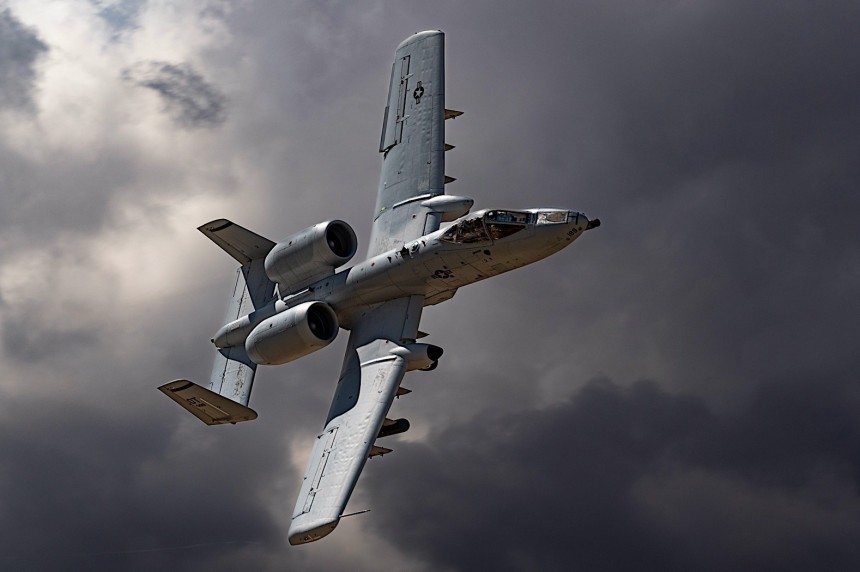The chances of Russia's newest main battle tank, the T-14 Armata, encountering America's close-air support hero, the A-10 Thunderbolt II, aren't all that great in the foreseeable future. Of course, unless the Russians decide to make a big boogaloo with NATO out of their mess in Ukraine. But that doesn't stop our noggins from joggin'. Can America's aging CAS heavyweight, built around a truck-sized 30 mm cannon, still call itself a tank buster?
As it turns out, the answer is more complicated than you might think. The reason why is that both the A-10 and the T-14's abilities are so often subject to hyperbole and exaggeration. But even if Russia and NATO never wind up going to war, Russia's already marketing the T-14 Armata to foreign markets. That makes the chances of a close encounter with an A-10 slightly more plausible.
To get an idea of what an engagement of an A-10 Warthog against a T-14 Armata might look like, we need to weigh the pros and cons of each vehicle, evaluate the tactics of their crews, and touch on some of the sketchier and more dubious assumptions made about both machines to dream up a scenario that at least makes logical sense. When it comes to the T-14 Armata, you'll find many aspects of itself are difficult to verify.
Never mind that Western intelligence has repeatedly caught Russia bringing the same T-14s to the back of the cue at military parades to make it look like they've manufactured more than they have. So much information about the Armata's armor, armament loadout, and sensor arrays are so painstakingly refined through Russian state media that believing it all as the gospel is a dubious assumption. That said, we do know at least a couple of things for sure.
Uralvagonzavod of Nizhny Tagil, Russia, the primary contractor and manufacturer of the T-14, is one of the Federation's most historic military design bureaus. With many Russo-Soviet tank designs to their name, like the T-34, T-54, T-62, T-72, and the T-90, "Ural," as it's often shortened, knows well how to adapt to ever-changing combat environments. Or at least, they should, in theory.
In reality, deficits in money and staffing since the fall of the Soviet Union mean Ural has made do with very little of either for the last 30 years. Given the T-14 has no dedicated air-to-air capability outside of a lucky shot with a Sprinter anti-tank missile, its armor and maneuverability alone would determine whether it survived an encounter with an A-10. At least on paper, the T-14's lightweight, 1,400-millimeter-thick explosive reactive armor (ERA), thick main hull armor, and Afganit active protection system (APS) give the T-14 a fighting chance against a wide degree of autocannon fire. You know, like the 30 mm shells fired from a certain Gau-8/A Avenger.
With a 1,500 horsepower, twin-turbocharged diesel V12, Russian sources reckon the Armata can hit a top speed between 75 and 80 km/h (47–50 mph). Not fast enough to outrun the American king of close-air support, but impressive for a main battle tank. Then again, no one outside of Ural themselves has been able to verify this. But it's important to remember that tanks seldom travel alone.
In modern Russian battalion tactical groups (BTG), tanks like T-72s and T-90s travel in cohorts flanked by other vehicles. Everything from small infantry fighting vehicles (IVFs) like BMP-3s, self-propelled artillery, and even dedicated anti-air batteries are included in these groups. Russian BTGs routinely travel with ZSU-23-4 Shilka mobile 23 mm anti-aircraft vehicles and 2K22 Tunguska surface-to-air-missile (SAM) launchers. Considering the U.S. Air Force seldom deploys the A-10 without air superiority or, more appropriately, complete air dominance, these threats would have to be neutralized by other means for this encounter to occur.
It may be tempting to say the Warthog's Gau-8 cannon could definitively knock out a T-14 with ease. But it's important to note the capabilities of the A-10 aren't free from embellishment. Direct hits from an A-10's cannon are not guaranteed to kill shots, far from it. As YouTube's favorite armchair war buff LazerPig pointed out in his two-part documentary about why he thinks the A-10 "sucks," the Pentagon themselves verified this in November 1979 through the Naval Postgraduate School in California.
In this test, a single A-10 engaged a formation of ten American M47 Patton main battle tanks mimicking a Soviet formation were engaged by a single A-10. Though the Warthog landed roughly 50 percent of its shots on target, it was found the damage done to the tanks would have only temporarily knocked out all but one of the ten test dummies. But by the same metric, the A-10 indeed helped lay waste to Soviet armor in the hands of the Iraqis during Operations Desert Storm and Desert Shield.
Many media outlets, both in print and online, have claimed that A-10s destroyed 900 Iraqi tanks during the First Gulf War. But don't be fooled. That number is another product of spotty record keeping and embellishment via the Warthog's ascendancy to mythic status later in its career. More accurate CIA and Department of Defense studies peg the real number of tanks felled by Warthogs in Iraq as around 300. This means the A-10 can indeed destroy tanks as intended. But to say they could single-handedly slice any Soviet tank to pieces in one pass with its cannon alone, regardless of the circumstances, would be categorically false, almost even laughable.
So then, let's set the stage. Let's say a hypothetical enemy force, either the Russians or somebody else, is operating a company of ten T-14 Armatas when a squadron of, say, six or seven A-10s finds the tanks in their targeting computers. Let's also assume that either the A-10s themselves or something else, like an F-15E Strike Eagle or an F-35 Lighting II, has taken care of all the above-mentioned anti-air threats. Oh, and there also aren't any shoulder-mounted rocket launchers around, either. Can the Warthog's cannon damage even a single T-14? Well, the answer is a definitive with long-range missiles"possibly?"
The answer really hinges on whether or not the T-14s layered explosive reactive armor system is as effective as Ural claims it to be and not just more state propaganda. In the event Ural is lying about the effectiveness of the T-14's armor, the A-10 Gau-8 might be able to punch through its weaknesses and even land a lucky shot on the tank's ammo storage. But even if the Avenger cannon can't knock out a T-14, the A-10's assortment of smart bombs, rockets, and guided air-to-ground missiles should be able to knock out the majority of a ten-count formation of Armatas. Fun fact, an A-10 can carry twice as many bombs by weight as a quad-engine B-17 bomber from World War II. Imagine a column of T-14s taking all of that ordnance to the face.
The truth of the matter is there aren't nearly enough T-14s in existence to verify how it'd perform against Ukrainian hardware, let alone American. Outside of a few reports from Russian State media assets, there hasn't been verification that the T-14s even showed up in Ukraine in any capacity as of early May 2023. But remember, Russian/Soviet tanks tend to proliferate worldwide to nations who, for some reason, can't get their hands on NATO tanks. This means that one day in the future, the possibility of an encounter between America's favorite attack jet and Russia's darling main battle tank might be more likely than ever before.
Regardless of the particulars of the affair, expect both sides of the engagement to fudge the numbers one way or another as suits their interests for the foreseeable future. As if to make the jobs of war historians many decades after the fact all the more a pain in the you-know-what. Check out LazerPig's video on the flaws of the T-14 Armata down below if you want to learn more. You'll never laugh so much while learning about history.
To get an idea of what an engagement of an A-10 Warthog against a T-14 Armata might look like, we need to weigh the pros and cons of each vehicle, evaluate the tactics of their crews, and touch on some of the sketchier and more dubious assumptions made about both machines to dream up a scenario that at least makes logical sense. When it comes to the T-14 Armata, you'll find many aspects of itself are difficult to verify.
Never mind that Western intelligence has repeatedly caught Russia bringing the same T-14s to the back of the cue at military parades to make it look like they've manufactured more than they have. So much information about the Armata's armor, armament loadout, and sensor arrays are so painstakingly refined through Russian state media that believing it all as the gospel is a dubious assumption. That said, we do know at least a couple of things for sure.
Uralvagonzavod of Nizhny Tagil, Russia, the primary contractor and manufacturer of the T-14, is one of the Federation's most historic military design bureaus. With many Russo-Soviet tank designs to their name, like the T-34, T-54, T-62, T-72, and the T-90, "Ural," as it's often shortened, knows well how to adapt to ever-changing combat environments. Or at least, they should, in theory.
With a 1,500 horsepower, twin-turbocharged diesel V12, Russian sources reckon the Armata can hit a top speed between 75 and 80 km/h (47–50 mph). Not fast enough to outrun the American king of close-air support, but impressive for a main battle tank. Then again, no one outside of Ural themselves has been able to verify this. But it's important to remember that tanks seldom travel alone.
In modern Russian battalion tactical groups (BTG), tanks like T-72s and T-90s travel in cohorts flanked by other vehicles. Everything from small infantry fighting vehicles (IVFs) like BMP-3s, self-propelled artillery, and even dedicated anti-air batteries are included in these groups. Russian BTGs routinely travel with ZSU-23-4 Shilka mobile 23 mm anti-aircraft vehicles and 2K22 Tunguska surface-to-air-missile (SAM) launchers. Considering the U.S. Air Force seldom deploys the A-10 without air superiority or, more appropriately, complete air dominance, these threats would have to be neutralized by other means for this encounter to occur.
It may be tempting to say the Warthog's Gau-8 cannon could definitively knock out a T-14 with ease. But it's important to note the capabilities of the A-10 aren't free from embellishment. Direct hits from an A-10's cannon are not guaranteed to kill shots, far from it. As YouTube's favorite armchair war buff LazerPig pointed out in his two-part documentary about why he thinks the A-10 "sucks," the Pentagon themselves verified this in November 1979 through the Naval Postgraduate School in California.
Many media outlets, both in print and online, have claimed that A-10s destroyed 900 Iraqi tanks during the First Gulf War. But don't be fooled. That number is another product of spotty record keeping and embellishment via the Warthog's ascendancy to mythic status later in its career. More accurate CIA and Department of Defense studies peg the real number of tanks felled by Warthogs in Iraq as around 300. This means the A-10 can indeed destroy tanks as intended. But to say they could single-handedly slice any Soviet tank to pieces in one pass with its cannon alone, regardless of the circumstances, would be categorically false, almost even laughable.
So then, let's set the stage. Let's say a hypothetical enemy force, either the Russians or somebody else, is operating a company of ten T-14 Armatas when a squadron of, say, six or seven A-10s finds the tanks in their targeting computers. Let's also assume that either the A-10s themselves or something else, like an F-15E Strike Eagle or an F-35 Lighting II, has taken care of all the above-mentioned anti-air threats. Oh, and there also aren't any shoulder-mounted rocket launchers around, either. Can the Warthog's cannon damage even a single T-14? Well, the answer is a definitive with long-range missiles"possibly?"
The answer really hinges on whether or not the T-14s layered explosive reactive armor system is as effective as Ural claims it to be and not just more state propaganda. In the event Ural is lying about the effectiveness of the T-14's armor, the A-10 Gau-8 might be able to punch through its weaknesses and even land a lucky shot on the tank's ammo storage. But even if the Avenger cannon can't knock out a T-14, the A-10's assortment of smart bombs, rockets, and guided air-to-ground missiles should be able to knock out the majority of a ten-count formation of Armatas. Fun fact, an A-10 can carry twice as many bombs by weight as a quad-engine B-17 bomber from World War II. Imagine a column of T-14s taking all of that ordnance to the face.
Regardless of the particulars of the affair, expect both sides of the engagement to fudge the numbers one way or another as suits their interests for the foreseeable future. As if to make the jobs of war historians many decades after the fact all the more a pain in the you-know-what. Check out LazerPig's video on the flaws of the T-14 Armata down below if you want to learn more. You'll never laugh so much while learning about history.





















